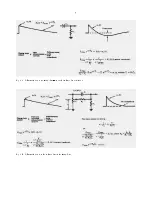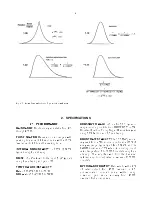
4
Fig. 1.3. Pulse Shapes for Good Signal-to-Noise Ratios.
2. SPECIFICATIONS
2.1. PERFORMANCE
GAIN RANGE
Continuously adjustable from X1
through X1500.
PULSE SHAPING
Gaussian on all ranges with
peaking time equal to 2.2τ and pulse width at 0.1%
level equal to 2.9 times the peaking time.
INTEGRAL NONLINEARITY
<0.05% (0.025%
typical) using 2 µs shaping.
NOISE
<8 µV referred to the input (5 µV typical)
using 2 µs shaping and gain
$
100.
TEMPERATURE INSTABILITY
Gain
#
0.0075%/
E
C, 0 to 50
E
C.
DC Level
<±50 µV/
E
C, 0 to 5O
E
C.
CROSSOVER WALK
#
±3 ns for 50:1 dynamic
range, including contribution of ORTEC 551 or 552
Constant-FractionTimingSingle-ChannelAnalyzer
using 50% fraction and 0.5 µs shaping.
COUNT RATE STABILITY
The 1.33 MeV gamma
ray peak from a
60
Co source, positioned at 85% of
analyzer range, typically shifts <0.024%, and its
FWHM broadens <16% when its incoming count
rate changes from 0 to 100000 counts/s using 2 µs
shaping. The amplifier will hold the baseline
reference up to count rates in excess of 150000
counts/s.
OVERLOAD RECOVERY
Recovers to within 2%
of rated output from X300 overload in 2.5
nonoverloaded unipolar pulse widths, using
maximum gain; same recovery from X1000
overload for bipolar pulses.
Содержание 572A
Страница 6: ...vi...
Страница 24: ...18 Fig 4 16 Gamma Ray Charged Particle Coincidence Experiment Fig 4 17 Gamma Ray Pair Spectrometry...
Страница 26: ...20 Fig 5 1 Amplifier Block Diagram...











































